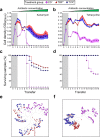Obligate mutualistic cooperation limits evolvability
- PMID: 35039522
- PMCID: PMC8764027
- DOI: 10.1038/s41467-021-27630-9
Obligate mutualistic cooperation limits evolvability
Abstract
Cooperative mutualisms are widespread and play fundamental roles in many ecosystems. Given that these interactions are often obligate, the Darwinian fitness of the participating individuals is not only determined by the information encoded in their own genomes, but also the traits and capabilities of their corresponding interaction partners. Thus, a major outstanding question is how obligate cooperative mutualisms affect the ability of organisms to adapt evolutionarily to changing environmental conditions. Here we address this issue using a mutualistic cooperation between two auxotrophic genotypes of Escherichia coli that reciprocally exchanged costly amino acids. Amino acid-supplemented monocultures and unsupplemented cocultures were exposed to stepwise increasing concentrations of different antibiotics. This selection experiment reveals that metabolically interdependent bacteria are generally less able to adapt to environmental stress than autonomously growing strains. Moreover, obligate cooperative mutualists frequently regain metabolic autonomy, resulting in a collapse of the mutualistic interaction. Together, our results identify a limited evolvability as a significant evolutionary cost that individuals have to pay when entering into an obligate mutualistic cooperation.
© 2022. The Author(s).
Conflict of interest statement
The authors declare no competing interests.
Figures





References
-
- Kirk DL. Evolution of multicellularity in the volvocine algae. Curr. Opin. Plant Biol. 1999;2:496–501. - PubMed
-
- Sachs JL, Mueller UG, Wilcox TP, Bull JJ. The evolution of cooperation. Q. Rev. Biol. 2004;79:135–160. - PubMed
-
- Kroiss J, et al. Symbiotic streptomycetes provide antibiotic combination prophylaxis for wasp offspring. Nat. Chem. Biol. 2010;6:261–263. - PubMed
Publication types
MeSH terms
LinkOut - more resources
Full Text Sources

